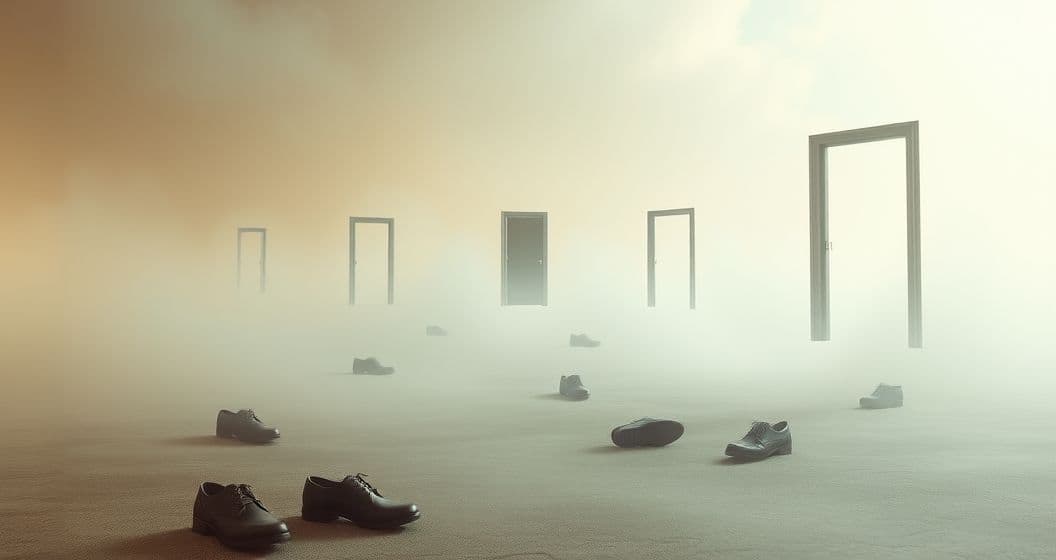Core Symbols: The Language of Missing Footwear and Flight
Dreams of missing shoes often emerge as a visceral reminder of instability, even when the mind is at rest. Shoes, in the dream lexicon, represent the tools we use to traverse life’s path—both literally, as the physical foundation of movement, and figuratively, as the skills, identities, or resources that ground us in purpose. When these shoes vanish, the subconscious signals a deeper unease: perhaps a sense that you’re adrift without the right 'footing' to pursue your goals, or that you’ve lost touch with the self you once knew. Consider a scenario where you’re rushing to catch a flight but realize your shoes are gone—your feet, raw and exposed, can’t carry you forward, even as the opportunity looms.
Flight doorways, by contrast, are portals to possibility. In dreams, flight often symbolizes transcendence, freedom from constraints, or the urge to rise above challenges. Missing a flight, however, introduces a layer of urgency and loss: you’re on the cusp of something transformative, but the door closes before you can step through. This dual imagery—shoes (grounding) and flight (ascension)—creates a paradox: the very thing that propels us upward (flight) requires the stability of our roots (shoes). When both are missing, the dream speaks to a disconnect between where you want to go and how you’re equipped to get there.
Psychology Lens: The Brain’s Unfinished Business
Want a More Personalized Interpretation?
Get your own AI-powered dream analysis tailored specifically to your dream
🔮Try Dream Analysis FreeNeuroscience offers a window into these dreams: during REM sleep, the amygdala—the brain’s emotional processing center—activates, sifting through recent stressors and unprocessed emotions. Dreams of missed opportunities like flights and lost shoes may be the mind’s way of rehearsing emotional responses to real-life setbacks. Cognitive psychology adds that these dreams function as 'problem-solving simulations,' helping us process 'what if' scenarios without the risk of real-world consequences.
From a Jungian perspective, missing shoes and flight doorways can reflect the 'shadow self'—the parts of ourselves we’ve neglected or avoided. The flight might represent a repressed desire for growth, while the missing shoes symbolize the 'shadow' of self-doubt that prevents us from taking action. Consider Carl Jung’s concept of the 'active imagination': these dreams invite us to engage with our inner conflicts, not as warnings, but as invitations to understand what we’re avoiding.
Life Triggers: The Real-World Echoes
Transitions are the most common triggers for these dual dreams. Starting a new job, moving cities, or ending a relationship can leave us feeling untethered—like we’ve lost our 'shoes' (old routines, familiar identities) just as new 'flight' opportunities (career shifts, personal growth) emerge. Fear of inadequacy often amplifies this: if you’ve recently questioned your skills or worth, the 'missing shoes' may mirror that uncertainty, while the 'flight' represents the escape you crave from self-doubt.
Modern life’s pressure to 'keep up' exacerbates these themes. Social media, with its curated highlights of success, can turn flight doorways into symbols of 'what everyone else has.' Meanwhile, the 'shoes' we wear—whether literal (professional attire) or metaphorical (self-presentation)—may feel inadequate or inauthentic, leading to the subconscious cry of 'I can’t move forward without them.'
What To Do Next: Reclaiming the Journey
Short-term reflection: Journal about the dream’s details—where were you, what emotions did you feel, and what flight/footwear felt most urgent? Ask yourself: What 'flight' opportunities have I hesitated to pursue? What 'shoes' (skills, support, or self-trust) am I missing? This reflection helps map the emotional terrain without judgment.
Medium-term experimentation: Identify one small 'shoe' you can 'put on'—a skill to develop, a conversation to have, or a boundary to set. For example, if the dream reflects career anxiety, research a new skill or schedule a coffee with a mentor. Notice how these small steps shift your relationship to 'flight' opportunities.
Long-term integration: Align your daily actions with your core values. If flight represents growth, ask: What daily 'shoes' (habits, relationships) support that growth? If shoes symbolize self-trust, practice small acts of courage to rebuild confidence. Over time, these steps transform 'missing' into 'claiming.'
FAQ
Q: What if I dream about both missing shoes and flight in the same dream?
A: This often signals a conflict between wanting to move forward (flight) and feeling unprepared (missing shoes). It’s a call to bridge that gap by identifying what’s holding you back.
Q: Are these dreams always negative?
A: No—they can also be creative prompts. If you feel inspired to take a risk or reevaluate your path, the dream may be guiding you toward growth, not just warning.
Q: How do I tell if this is about a specific opportunity I’m missing?
A: Reflect on recent uncompleted tasks, relationships, or goals. Dreams often mirror current life themes, so connect the 'flight' to a concrete opportunity and 'shoes' to your readiness for it.
